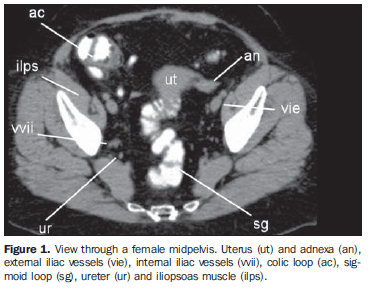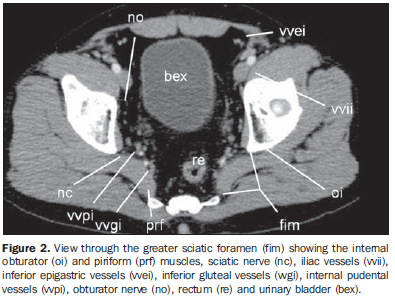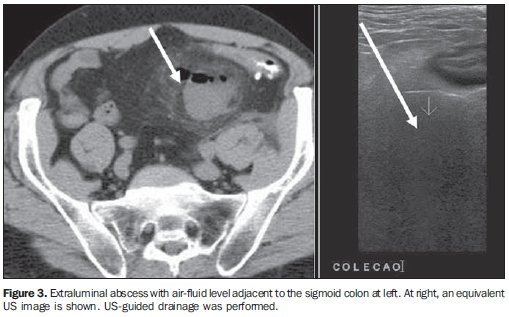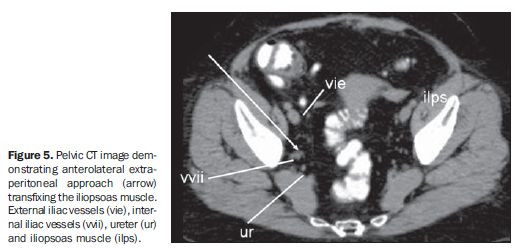Radiologia Brasileira - Publicação Científica Oficial do Colégio Brasileiro de Radiologia
AMB - Associação Médica Brasileira CNA - Comissão Nacional de Acreditação
 Vol. 41 nº 5 - Sep. / Oct. of 2008
Vol. 41 nº 5 - Sep. / Oct. of 2008
|
ICONOGRAPHIC ESSAY
|
|
Image-guided percutaneous procedures in deep pelvic sites: review of the main approaches |
|
|
Autho(rs): Rodrigo Gobbo Garcia, Carlos Leite de Macedo Filho, Alexandre Maurano, Miguel José Francisco Neto, Mauro Miguel Daniel, Laercio Alberto Rosemberg, Marcelo Buarque de Gusmão Funari |
|
|
Keywords: Biopsies, Percutaneous drainage, Interventional procedures, Pelvic anatomy, Pelvic abscesses |
|
|
Abstract:
IMD, Radiologist, Physician Assistant at Unit of Nonvascular Interventional Radiology, Hospital Israelita Albert Einstein, and Instituto de Radiologia do Hospital das Clínicas da Faculdade de Medicina da Universidade de São Paulo (InRad/HC-FMUSP), São Paulo, SP, Brazil
INTRODUCTION Image-guided percutaneous biopsy and drainage have been established as safe and effective procedures within the practice of interventional radiology, accounting for the majority of nonvascular procedures in departments of imaging diagnosis. These methods represent safe and effective tools for a minimally invasive management of different clinical and surgical conditions, if appropriately performed(1-8). However, deeper pelvic lesions most frequently represent a challenge for interventional radiologists, because of the presence of several intervening anatomic structures within the pelvic space that, besides being relatively small, is involved by a rigid bone structure. Bowel loops, urinary bladder, neurovascular structures, uterus and adnexa in female patients represent obstacles which should be carefully circumvented as possible. The successful procedure depends essentially on a safe access planning requiring a thorough knowledge of the pelvic anatomy(1). The main approaches adopted for accessing deep pelvic lesions are the following: anterior and lateral transabdominal, anterolateral extraperitoneal, transvaginal, transrectal and transgluteal. The present study was aimed at reviewing the normal pelvic cross-sectional anatomy, demonstrating the different access routes for ultrasonography (US)- and computed tomography (CT)-guided pelvic biopsies and drainages, as well as discussing the main advantages and possible complications associated with these approaches.
THE NORMAL PELVIC ANATOMY A safe approach planning for biopsy of deep pelvic lesions requires knowledge of the complex anatomy of the region. Familiarity with the location and typical appearance of the different anatomic structures at CT is particularly relevant (Figures 1 and 2).
The choice of an access route and method to be adopted for the procedure will depend on the site of the lesion and the method availability. Whenever possible, US should be the method of choice, considering its lower expensiveness, besides allowing the management of the procedure with real-time images and without the necessity of ionizing radiation. In cases where the lesion is unapproachable by US, CT and, most recently, CT fluoroscopy may be utilized as alternative methods.
ANTERIOR OR LATERAL TRANSABDOMINAL APPROACH In this type of approach, the needle is inserted through the muscles of the lower abdominal wall and peritoneum. Inferior epigastric vessels adjacent to the rectus abdominis muscle, as well as deep circumflex iliac vessels ascending along the anterior abdominal wall near the iliac crest should be avoided. Additionally, it is important to consider that bowel loops occupy a major portion of the upper pelvis and constitute quite mobile structures that may frequently change their position during the course of the procedure. Bowel transgression should be avoided. Thin gauge needles (20 G or 22 G) can be safely utilized in cases where the bowel loops cannot be bypassed. Target-lesions to be reached by this approach are those located superior, anterior or laterally to the urinary bladder. The greatest advantage of this approach is that the patient can frequently remain supine that is a more comfortable positioning for long-lasting procedures. This technique is illustrated with the drainage of an abscess secondary to a complicated diverticulitis, where a US-guided procedure was performed with subsequent tomographic follow-up. (Figures 3 and 4).
ANTEROLATERAL EXTRAPERITONEAL APPROACH This technique involves the iliopsoas muscle transfixion to avoid injuries to deep circumflex iliac vessels, and should be preferentially utilized for target-lesions located medially to the iliopsoas muscle, such as lymphadenomegaly in deep iliac and obturator chains. Safety is the main advantage of this approach, considering that the needle is advanced laterally to the border of the iliac bone, with no risk to the visceral structures along the needle tract. So higher-gauge needles (16 G and 18 G) can be utilized, allowing a more representative sampling. Another advantage to be considered is that this approach is performed with the patient in dorsal decubitus, which is quite comfortable for patients who are unable to lie prone because of obesity, colostomy bags or incisions/wounds on the anterior abdominal wall. A potential risk of this approach involves injuries to the femoral nerve which courses in the fat plane between the iliac and psoas muscles. However, no similar complication was observed by the authors in their experience involving 15 cases. The disadvantage of this approach is that this procedure is usually more painful as compared with the transabdominal approach, requiring deeper sedation or analgesia. Biopsy of deep pelvic lesions is performed by transfixion of the iliopsoas muscle by means of coaxial needles, allowing repeated biopsy sampling through a same access route, and avoiding contact with vascular structures (Figures 5 and 6).
TRANSGLUTEAL APPROACH The patient is usually placed in ventral or lateral decubitus. This approach also is called transsciatic approach because the needle is inserted through the great sciatic foramen (Figure 2). If possible, the needle should transfix the sacrospinous ligament localized below the level of the piriform muscle to avoid injury to gluteal vessels and the sacral plexus which lie anterior to the muscle. Target-lesions to be approached by this method are those located posterior to the urinary bladder and adnexal masses (Figures 7 and 8). This approach presents the advantage of avoiding transfixion of the peritoneum, besides minimizing risks for injury to bowel loops, bladder and iliac vessels. Additionally, in the transgluteal approach, the needle is more stable for transfixing a static muscular mass in the absence of respiratory movements of the abdominal wall. However, the prone position is uncomfortable for the patients, making the ventilation and anesthetic management more difficult.
TRANSVAGINAL AND TRANSRECTAL APPROACHES These are simple and safe techniques, and frequently represent the sole access route for the management of some pelvic diseases. Aspiration of cystic masses and biopsy of solid masses can be easily performed by transvaginal or transrectal approach, with an endocavitary transducer and a biopsy guide (Figures 9, 10, 11 and 12). The major advantage of these techniques is that both are easy to perform through natural pelvic orifices, constituting an extremely useful access in the approach of cul-de-sac lesions, as well as lesions in the adnexal and prostatic regions. Considering that this is a semi-sterile procedure, even involving risk for contamination (transrectal approach), additional care should be taken in relation to the patient preparation. Antisepsis of the vaginal and rectal cavities with povidine iodine is recommended, besides fleet-enema in cases of transrectal procedures. Prophylactic intravenous antibiotic-therapy (cephoxitin 1g or clindamycin 1g + gentamycin 80 mg + ampicillin 1g) is mandatory. Additionally a 300 mg-dose of clindamycin each six hours for five days may be recommended(5). Collections and cysts must be completely drained in order to avoid hyperinfection by the rectovaginal flora(5). The transvaginal approach also is useful in cases of tubo-ovarian abscess, postoperative abscess and complications resulting from intestinal conditions (Crohn's disease, apendicitis or diverticulitis) for allowing the insertion of drains.
COMPLICATIONS Severe complications resulting from these methods are extremely rare. Vasovagal reaction, pain, local bleeding and infection are the main complications. Most of times, hematomas observed along the needle track resolve spontaneously. Familiarity with the pelvic anatomy and preprocedural laboratory evaluation to exclude patients at high risk of bleeding minimize the chance of clinically significant bleeding. Piriform muscle transfixion with the transgluteal approach may result in irritation of the sciatic nerve or sacral plexus. This reaction is usually self-limiting and resolve within 24 hours following the procedure.
CONCLUSIONS The knowledge of cross-sectional pelvic anatomy facilitates the choice of an appropriate approach in US- or CT-guided interventional procedures, increasing the effectiveness of the method. Familiarity with interventional percutaneous techniques and materials, in association with risk factors evaluation reduce the incidence of complications.
REFERENCES 1. Gupta S, Nguyen HL, Morello FA Jr, et al. Various approaches for CT-guided percutaneous biopsy of deep pelvic lesions: anatomic and technical considerations. Radiographics. 2004;24:175-89. [ ] 2. McDowell R, Mueller P. Pelvic fluid collections: anatomy for interventional procedures. Semin Intervent Radiol. 1995;12:177-90. [ ] 3. Higgins J, Letourneau J. Percutaneous biopsy of abdominal masses. In: Casteñeda-Zuniga W, editor. Interventional radiology. Philadelphia: Williams & Wilkins; 1997. p. 1691-718. [ ] 4. Schweiger GD, Yip VY, Brown BP. CT fluoroscopic guidance for percutaneous needle placement into abdominopelvic lesions with difficult access routes. Abdom Imaging. 2000;25:633-7. [ ] 5. O'Neill MJ, Rafferty EA, Lee SI, et al. Transvaginal interventional procedures: aspiration, biopsy, and catheter drainage. Radiographics. 2001;21:657-72. [ ] 6. Harisinghani MG, Gervais DA, Hahn PF, et al. CT-guided transgluteal drainage of deep pelvic abscesses: indications, technique, procedure-related complications, and clinical outcome. Radiographics. 2002;22:1353-67. [ ] 7. Harisinghani MG, Gervais DA, Maher MM, et al. Transgluteal approach for percutaneous drainage of deep pelvic abscesses: 154 cases. Radiology. 2003;228:701-5. [ ] 8. Ryan RS, McGrath FP, Haslam PJ, et al. Ultrasound-guided endocavitary drainage of pelvic abscesses: technique, results and complications. Clin Radiol. 2003;58:75-9. [ ] Received February 26, 2008. * Study developed in the Department of Radiology and Image-Guided Procedures at Hospital Israelita Albert Einstein, São Paulo, SP, Brazil. |
|
Av. Paulista, 37 - 7° andar - Conj. 71 - CEP 01311-902 - São Paulo - SP - Brazil - Phone: (11) 3372-4544 - Fax: (11) 3372-4554




